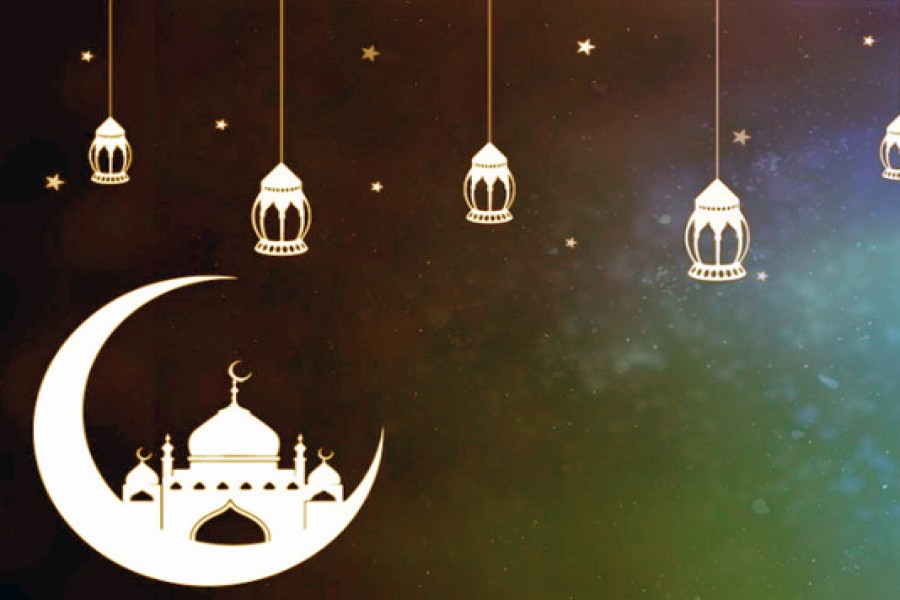The basis for the Eid-ul Azha comes from the 196th verse of the second Surah, Al Baqara (The Cow), in the Quran. The word "Eid" appears in the fifth Sura al-Mai'da (The Table Spread) meaning 'solemn festival'. The days of Eid-ul Azha are the 10th of Dhul Hijjah upto the 12th of Dhul Hijjah (three days and two nights). During this time, sacrifice may take place until sunset of the 13th day. In the Indian subcontinent, the festival is known as Bakri-Eid because of the tradition of sacrificing goats.
Eid-ul Azha, or 'Feast of the Sacrifice', is celebrated worldwide to honour the willingness of Hazrat Ibrahim (pbuh) to sacrifice his dearest son Ismail as an act of obedience to Allah, before He intervened to provide him with a sheep to sacrifice instead.
The Eid-ul Azha in-effect exists around the festivity of sacrifice, thus having an impact on the socio-economic arena.
Eid-ul Azha is observed after Hajj is performed by the financially solvent Muslims. The national economy has to transact a substantial amount, mostly in foreign currency, during this time. This year more than 110,000 pilgrims from Bangladesh have gone to Saudi Arabia for performing Hajj. Each pilgrim is expected to spend, on average, Tk 300,000. This means the total expenditure is about Tk 43 billion, equivalent to US$ 515 million.
Since the times when Hajj was introduced, it has been a major source of foreign currency income for the Saudi economy and an important area for foreign currency exchange expenditure for other economies. Bangladesh economy has had to handle banking transactions along with foreign currency exchange and job creation to aid hajj performers for decades till now.
Sacrificing the cattle remains the central activity during the Eid-ul Azha leading to huge funds involved in various economic activities. According to Bangladesh Tanners' Association (BTA), about 3,500,000 cows and 5,000,000 goats will be sacrificed this year. If this is so, then the trading of these animals will be worth a total of Tk 160 billion.
Bangladesh is heavily dependent on supply of cattle from India. Formally and informally, India exports about 10 million cattle to Bangladesh annually. Out of this, around four million are dispatched during this Eid. Bangladesh government should earn Tk 2 billion in revenue at Tk 500 per cattle.
Eid-ul Azha is also the main season for producing hides and skins. Sixty per cent of the total export of hides and skins is made following the celebration of this festival.
Markets for spices and electronic items like refrigerators, ovens etc. witness bumper sales during this time. The total sale of electronic products reaches a billion takas, ahead of Eid.
The money market, which usually gets volatile during the Eid festivals, remains calm in a fairly liquid position during this time, ahead of Eid and Durga Puja. The market is calm now because of a decline in imports and a rise in remittances.
The performance of Hajj and the sacrifice of cattle during Eid, in essence, generate money supply, which is expansionary in nature, promote trade and business, create jobs, and at large, ensures a boom for the economy. But, the fact remains, competent macro management of such supply side economy is crucial for sustainable development.
Cost-effectiveness of Hajj management can help the economy if own infrastructural facilities were there for transportation and accommodation of major portion of pilgrims (if not all) in an effective and efficient manner. The management of cattle as well as hide and skin trading still needs to be directed towards the right path. The economy would have been benefited by this important sector if a long-term plan was in place to handle border trade while checking corruption and the efficiency of syndicates.
A common observation has always been that the Eid cattle market is exploited by the three S: the syndicated traders, smugglers and snatchers. It has been reported that syndicated traders have targeted a market of Tk 320 billion from Bangladesh this year. They plan to earn this amount of money by exporting cows on credit and at the same time, by importing raw hides at lower prices through unofficial channels. Against smuggling of cows, they are receiving raw hides and bones, fuel, edible oil, gold, silver, cigarettes, jute etc. In such ways, the Bangladesh economy loses out on revenue and its own prospect of exporting leather and leather products abroad. Although the government provides credit facilities to tanneries, no credit is given to hide merchants who face difficulties to run their businesses. Ultimately the businessmen have to depend on smugglers who pay 'advance money' for procurement of hides and skins. For preservation of raw hide salt is an essential ingredient.
The government has been urged to allow duty-free import of 40,000 tons of salt in the interest of overcoming any ploy that the salt traders' syndicate may resort to in a bid to hike prices.
Cattle from border areas to different places including Dhaka have to pay illegal tolls. It starts from the border guards who are reportedly taking Tk 5,000 to 7,000 for a pair of cows. Extortion money has to be paid to police when the truck carrying the cattle crosses a district. Highway police has to be paid separately. There are many other points where money exchanges hands. Toll collectors are making money by exploiting the situation which they will use, ultimately for corrupting the society at large. Thus an authentic prospect of the economy is being hampered by management failure.
The transportation sector also sees a boom during this time of the year as a lot of people travel long distances within the country.
Muhammad Abdul Mazid is a former secretary and chairman of the NBR.


